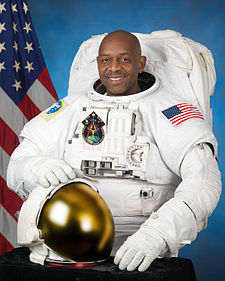Robert Satcher
| Robert Lee Satcher | |
|---|---|
 | |
| Astronaut NASA | |
| Státní příslušnost | USA |
| Datum narození | 22. září 1965 (57 let) |
| Místo narození | Hampton, Virginie, USA |
| Předchozí zaměstnání | Chirurg |
| Čas ve vesmíru | 10 dní, 19 hodin a 16 minut |
| Kosmonaut od | 6. května 2004 |
| Mise | STS-129/ISS |
| Znaky misí | |
| Kosmonaut do | 9. září 2011 |
| Pozdější zaměstnání | Chirurg |
| Některá data mohou pocházet z datové položky. | |
Robert Lee Satcher (* 22. září 1965 Hampton, Virginie, USA), je americký chirurg, který byl v letech 2004–2011 astronautem NASA. Do vesmíru se dostal na deset dní jako člen posádky raketoplánu Atlantis při letu STS-129 na Mezinárodní vesmírnou stanici (ISS) v listopadu 2009. Roku 2011 odešel z NASA a vrátil se k lékařské profesi.
Mládí, lékař
Robert Satcher se narodil v Hamptonu ve Virginii. Po střední škole studoval chemické inženýrství na Massachusettském institutu technologie, kde roku 1986 získal titul bakaláře a roku 1993 Ph.D. ve stejném oboru. Následující rok (1994 se stal doktorem medicíny (MD) na Harvardově lékařské škole (Harvard Medical School) při Harvardově univerzitě.[1]
Do roku 1998 byl výzkumníkem na Kalifornské univerzitě v Berkeley, poté se věnoval ortopedii na Kalifornské univerzitě v San Francisku a (2001) chirurgické onkologii na Floridské univerzitě. Poté do roku 2004 pracoval jako chirurg Severozápadní nemocnice (Northwestern Memorial Hospital) v Chicagu a současně na katedře ortopedie Lékařského centra Severozápadní univerzity (Northwestern University Medical Center).[1][2]
Astronaut a opět lékař

Přihlásil se k 19. náboru astronautů NASA úspěšně prošel výběrem a 19. května 2004 byl zařazen mezi americké astronauty. Ve dvouletém základním kosmonautickém výcviku získal kvalifikaci „letového specialisty“ raketoplánu.[2]
Dne 30. září 2008 NASA zveřejnila jeho jmenování do posádky letu STS-129.[3] Do vesmíru odstartoval 16. listopadu 2009 na palubě raketoplánu Atlantis. Cílem mise byla doprava zásob a vybavení na Mezinárodní vesmírnou stanici (ISS) a příprava stanice na připojení nového modulu Tranquility. Během mise dvakrát vystoupil do otevřeného vesmíru k pracím na povrchu stanice, výstupy trvaly dohromady 12 hodin a 19 minut. Let trval 10 dní, 19 hodin a 16 minut.[4]
K 9. září 2011 odešel z NASA a vrátil se k lékařské profesi, když začal pracovat jako chirurg v Andersonově onkologickém centru (Anderson Cancer Center) v Houstonu [2]
Robert Satcher je ženatý, má dvě děti.[1][2]
Reference
- ↑ a b c NASA. Biographical data. Robert L. Satcher, Jr. (PH.D., M.D.) [online]. NASA, rev. 2011-07 [cit. 2013-01-30]. Dostupné v archivu pořízeném dne 2014-08-08. (anglicky)
- ↑ a b c d IVANOV, Ivan, a kol. Космическая энциклопедия ASTROnote [online]. Moskva: rev. 2012-4-15 [cit. 2013-01-30]. Kapitola Robert Lee Satcher, Jr.. Dostupné online. (rusky)
- ↑ YEMBRICK, John; CLOUTIER-LEMASTERS, Nicole. Release: 08-250. NASA Assigns Crew For Space Shuttle Discovery's Sts-129 Mission [online]. Washington, Houston: NASA, 2008-9-30 [cit. 2013-01-30]. Dostupné online. (anglicky)
- ↑ HOLUB, Aleš. MEK. Malá encyklopedie kosmonautiky [online]. Rev. 2011-12-26 [cit. 2013-01-30]. Kapitola STS-129 At/F-31. Dostupné online.
Externí odkazy
 Obrázky, zvuky či videa k tématu Robert Satcher na Wikimedia Commons
Obrázky, zvuky či videa k tématu Robert Satcher na Wikimedia Commons
Média použitá na této stránce
Astronaut Robert L. Satcher Jr., mission specialist
Astronaut Robert L. Satcher Jr., STS-129 mission specialist, participates in the mission's first session of extravehicular activity (EVA) as construction and maintenance continue on the International Space Station. During the six-hour, 37-minute spacewalk, Satcher and astronaut Mike Foreman (out of frame), mission specialist, installed a spare S-band antenna structural assembly to the Z1 segment of the station's truss, or backbone. Foreman and Satcher also installed a set of cables for a future space-to-ground antenna on the Destiny laboratory and replaced a handrail on the Unity node with a new bracket used to route an ammonia cable that will be needed for the Tranquility node when it is delivered next year. The two spacewalkers also repositioned a cable connector on Unity, checked S0 truss cable connections, and lubricated latching snares on the Kibo robotic arm and the station's mobile base system.
For STS-129 the sun shines brightly on the International Space Station (ISS) above and the United States below representing the bright future of U.S. human spaceflight. The contiguous U.S., Rocky Mountains, and Great Desert Southwest are clearly visible on the earth below encompassing all the NASA centers and the homes of the many dedicated people that work to make our Space Program possible. The integrated shapes of the patch signifying the two Express Logistics Carriers that will be delivered by STS-129 providing valuable equipment ensuring the longevity of the ISS. The Space Shuttle is vividly silhouetted by the sun highlighting how brightly the Orbiters have performed as a workhorse for the U.S. Space Program over the past 3 decades. The Space Shuttle ascends on the Astronaut symbol portrayed by the Red, White and Blue swoosh bounded by the gold halo. This symbol is worn with pride by this U.S. crew representing their country on STS-129. The names of the crew members are denoted on the outer band of the patch. As STS-129 launches, the Space Shuttle is in its twilight years. This fact is juxtaposed by the 13 stars on the patch which are symbolic of our children who are the future. The Moon and Mars feature predominantly to represent just how close humankind is to reaching further exploration of those heavenly bodies and how the current Space Shuttle and ISS missions are laying the essential ground work for those future endeavors.


